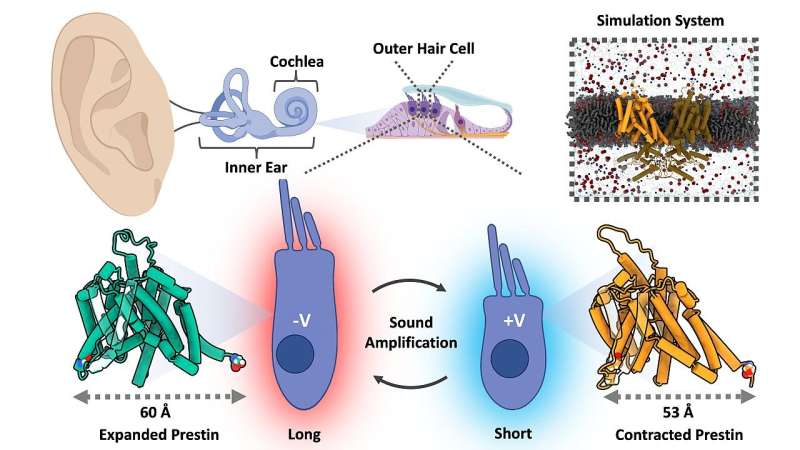This article has been reviewed according to Science X's editorial process and policies. Editors have highlighted the following attributes while ensuring the content's credibility:
fact-checked
peer-reviewed publication
trusted source
proofread
Elevating our understanding of inner ear sound amplification

Our ability to detect different sounds intensities and pitches with great sensitivity is largely due to the inner ear's ability to decode sound waves and amplify individual frequencies. Since the discovery of the anion transporter homolog prestin as the molecular membrane motor responsible for sound amplification in the inner ear in 2000, it has been the subject of great interest, given prestin's inclusion in the Solute Carrier 26 (SLC26) protein family.
In addition to evolving into a voltage-dependent membrane motor, mammalian prestin lost the ability to transport solutes—leading to wide speculation as to its underlying molecular mechanisms. The other SLC26 proteins transport ions across the cell membrane using an elevator-transport mechanism, which involves a vertical movement of a mobile transport-domain against a static scaffold-domain. Mammalian prestin's unique electrical and mechanical ability, known as electromotility, has remained enigmatic thus far.
Scientists from the Institute of Molecular and Cellular Physiology of Forschungszentrum Jülich (IBI-1) and Philipps-University Marburg have now combined atomistic molecular-dynamics simulations on Jülich's supercomputers and advanced electrophysiological experiments to provide a description of prestin's electromotility.
These results, now published in the journal Nature Communications, reveal the molecular mechanisms of sound amplification by prestin at atomic resolution.
The researchers found that voltage fluctuations across so-called outer hair cells in the inner ear (caused by sound-induced vibrations) induce changes in prestin from its compact to its expanded conformation, or vice versa. These conformational changes trigger length changes of the hair cells and thus vibrations of the sound frequency are amplified.
The mammalian ear has evolved exquisite sensitivity to different frequencies, important for human communication. These results provide important insights into sound processing and amplification in the inner ear and could help develop novel therapeutic approaches for deafness.
More information: Makoto F. Kuwabara et al, Elevator-like movements of prestin mediate outer hair cell electromotility, Nature Communications (2023). DOI: 10.1038/s41467-023-42489-8
Journal information: Nature Communications
Provided by Forschungszentrum Juelich




















